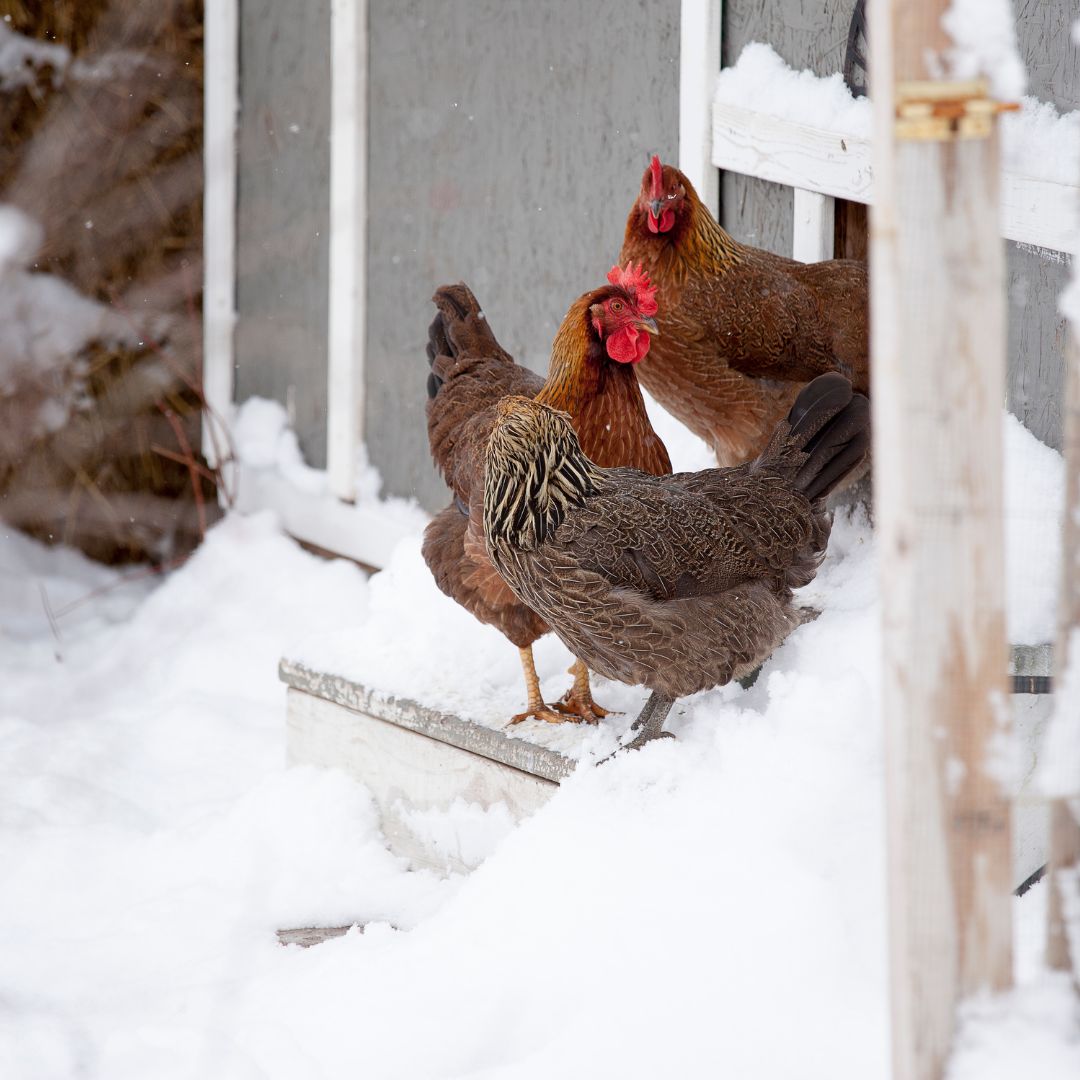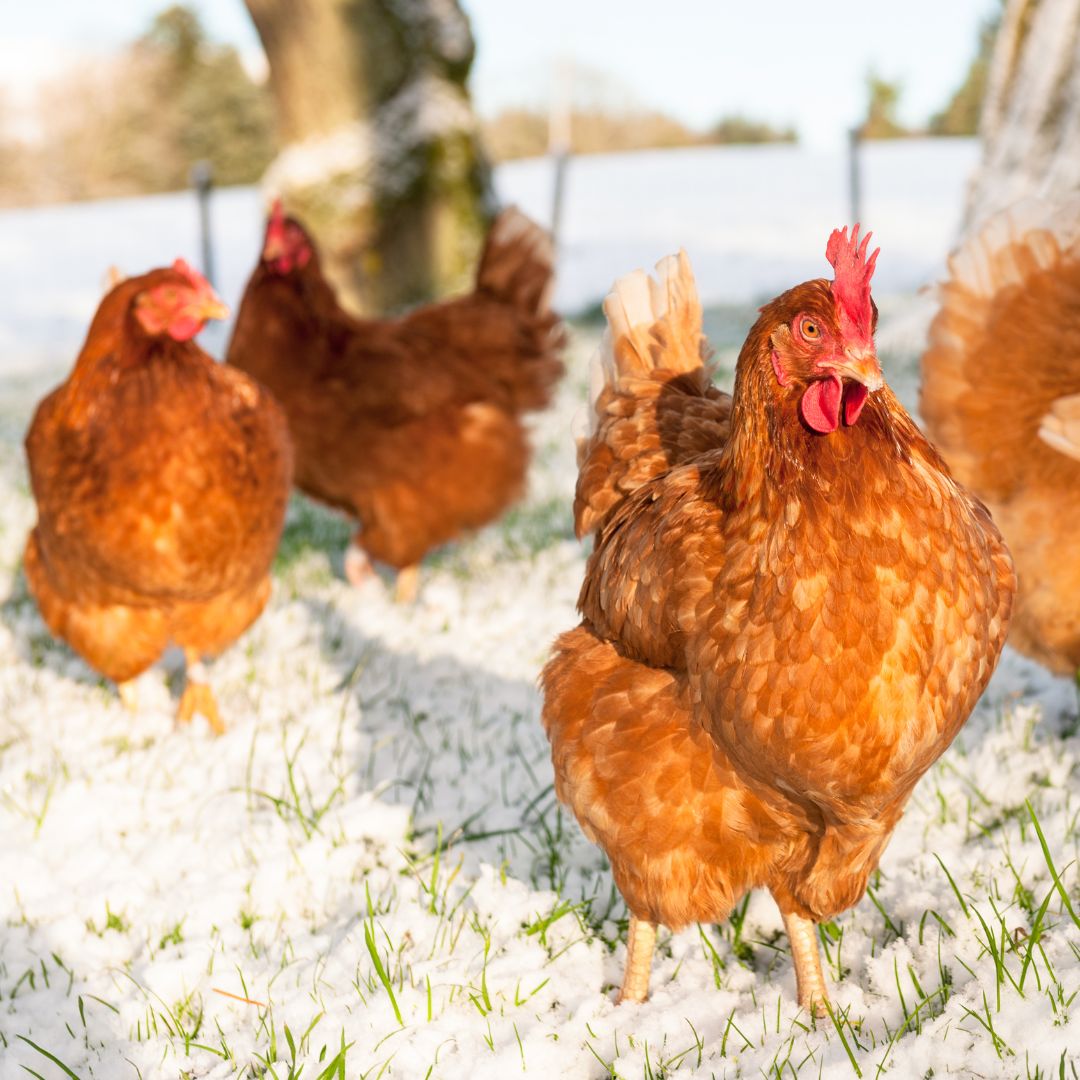Winter Care Tips for Laying Hens
Margit Kaltenekker
Agriculture Agent
Whether you’ve started a fall flock of layers for next spring, or you aim to keep your layers going strong through winter, the following are some key tips to keeping your flock well-fed, well-watered, healthy and comfortable. Taking preventative measures reduces risk of any burden of stress which can lead to sudden molt or cease or decrease egg production.
Most of the heavy breeds are more tolerant of cold temperatures and adapt easily to fluctuations in temperature. These include: Ameraucanas, Ancona, Black Australorps, Black Giant, Brahma, Buff Orpingtons, Cochins, Delaware, Dominique, Langshan, New Hampshire, Plymouth Rocks, Rhode Island Red, Speckled Sussex and Wyandottes. However, winter hardy breeds having larger combs and wattles can make them more susceptible to develop frostbite. Strategies for prevention and treatment of frostbite are addressed further below.
Ameraucanas, Ancona, Black Australorps, Black Giant, Brahma, Buff Orpingtons, Cochins, Delaware, Dominique, Langshan, New Hampshire, Plymouth Rocks, Rhode Island Red, Speckled Sussex and Wyandottes. However, winter hardy breeds having larger combs and wattles can make them more susceptible to develop frostbite. Strategies for prevention and treatment of frostbite are addressed further below.
Culling: Humane husbandry includes the difficult decisions of culling the flock. Observe and Identify those birds that may not adapt to the colder weather: remove older birds, poorly performing, weak, thin, or sick birds prior to winter. This is a sure way to reduce risks of prolonged stress, or death and is the more humane option. Observe and weigh your birds to make those decisions now.
Preparing the Coop to provide safe shelter and comfortable quarters will depend on multiple factors. Check these essential conditions, fine-tune, and adjust before winter fully settles in:
Spacing in a Coop: Chickens need 2 -3 square feet of floor space per bird. This amount of space is most comfortable and stress free.
Block Drafts: While you need to ensure the coop is well-ventilated, chickens don’t like cold drafts.
Check high and low, check all corners, all doors, and windows for drafts by holding a wet hand to feel for airflow, or hold a tissue around the joints, edges, and seams to locate drafts. Make sure doors and windows can be shut tightly and locked to maintain temperature. The worst-case scenario is having the coop door blow open during a blizzard, killing your flock. Check and seal or repair holes to prevent air, moisture, rodents, or vermin from entering the coop. (Turn on a light inside the coop at night and inspect from the outside of the coop to locate points of entry). Make necessary repairs during the warmer days of fall. Prevent chickens from accessing any spray foam insulation or caulking sealants.
Ventilation: Complications arise in winter when wind and moisture are combined with cold temperatures. Birds must be kept dry and protected from drafts and excessive winds, while still allowing steady air exchange. There is a balance between maintaining relatively steady temperatures in the coop, and controlling air-flow to prevent excess moisture, humidity and ammonia build up. Maintaining air quality during extremely cold temperatures is essential to a healthy flock. Small ventilation fans on a thermostat or simple louvered vents can make a real difference. Excess ammonia buildup from litter in a tightly sealed coop can lead to problems with respiratory health. Excess moisture buildup and humidity increases the risk of frostbite even inside the coop! Cold and dry air or warm (50F) dry air is far better than warm and moist, or cold and moist air.
Bedding: Remove all used bedding each spring and fall. Thoroughly clean and disinfect the coop prior to adding a fresh base (4 -6 in) of deep litter, dry bedding. Pine shavings or chips are ideal but bedding materials may include soft hay, straw, shredded paper or ground corn cobs. The chickens will appreciate a thick layer of insulation as a place to get warm, and a place to scratch. However, deep bedding will increase humidity levels. Litter management is critical during winter months. You need to check the moisture levels in the coop daily; you may need to clean the coop more frequently or regularly adjust, mix or fluff the litter to provide a warm, dry environment. Remove wet, frozen and humid litter to prevent frostbite to chickens’ feet.
Sanitation: As the word implies, Sanitation protocol helps prevent sickness and disease. Keep all areas of the coop clean. Keep the litter changed, cleaned, and dry. Change out soiled feed and dirty water immediately. Keep feeders, roosts, nesting boxes, and waterers clean. Herbal teas of oregano, and thyme added to the water, can help keep the flock healthy since these herbs have anti-viral properties.
Heating: Supplemental heat may or may not be necessary in the Coop. Chickens are hardy animals with an ability to withstand substantially cool temps – provided drafts and cold are eliminated and they find a warm, dry spot in the coop. Allow the chickens to acclimate to the colder temps naturally. Allowing the chickens to acclimate naturally increases the chickens’ tolerance to cold.
Insulating the coop can be a cost-effective way to maintain warm temperatures without the need for electricity. External Insulation around the outside of the coop might include stacked straw bales, or bagged leaves. If the coop has open air-fenced sides, wrap a heavy tarp or thick plastic ¾ of the way up the fenced sides to prevent cold wind, drafts, and moisture from entering the run at ground level.
If supplemental heating is required, make sure the electrical supply to the coop is installed by an electrician to be sturdy, safe and inaccessible to poultry. Avoid excess heat, carbon dioxide buildup or a fire hazard when using space heaters, radiant lamps or heat lamps.
The beauty of winter hardy, cold-tolerant breeds acclimated to the weather, living in an insulated, dry coop with adequate ventilation is that they do not usually need supplemental heat.
Egg Production: Hens will continue maximum egg production with 16 hours of light per 24 hours. Because you want the birds to settle to roost at sunset, the light should be on a timer to turn on in the middle of the night and off at daybreak. The maximum daylength at winter solstice at 40 degrees latitude is 9 hours 20 min. Gradually increase up to 7 hours of nighttime lighting from late fall to winter solstice; then decrease accordingly after winter solstice. A 60-watt incandescent light or 13-watt compact fluorescent or comparable LED hung at 7 ft height with a white reflector will provide adequate light for a 200 sq. ft. coop. Keep bulbs and fixtures clean for efficiency, brightness, and quality.
to roost at sunset, the light should be on a timer to turn on in the middle of the night and off at daybreak. The maximum daylength at winter solstice at 40 degrees latitude is 9 hours 20 min. Gradually increase up to 7 hours of nighttime lighting from late fall to winter solstice; then decrease accordingly after winter solstice. A 60-watt incandescent light or 13-watt compact fluorescent or comparable LED hung at 7 ft height with a white reflector will provide adequate light for a 200 sq. ft. coop. Keep bulbs and fixtures clean for efficiency, brightness, and quality.
Collect Eggs twice daily to avoid frozen eggs. Check more frequently during bitter cold temps. Time collection with feeding and water changes. Dispose of cracked or frozen eggs.
Roosting: Provide sturdy, comfortable roosts so the entire flock can all rest at the same time. Allow 6 – 8 inches linear space per hen. Make sure the roosts are made of wood not metal; 1.5 – 3 in diameter. Round stock is preferred. Tree limbs work fine.
Well-Watered: Fresh, clean water is essential to a flock’s diet and necessary for their digestion. Chickens need free access to fresh, clean water. Change the water twice daily. Hens will suffer after 10 hours without water, so keeping the water from freezing during cold winter months is very important. A heated aluminum water fount is ideal. Having a heated base to set a metal fount on is also an excellent choice. For those without electricity in their coop utilize aluminum or rubber buckets which do not split like plastic when water freezes. Be sure to keep them partially covered in an insulated box. Open buckets increase the risk of wet feet (which can lead to frostbite), spillage or drowning. Having at least two buckets gives you one to trade out to thaw– as you water your birds each day.
Well-Fed: Stock up on a winter supply of feed. You never want to be caught off guard without feed, during a prolonged weather event, outages, etc. Pullets need a Grower Feed of 16-18% protein with less calcium than layer feed (until 18- 20 weeks old). For the layers, supply a 14-16% Crude Protein Layer Ration so the birds are never without feed. Birds will consume more feed during extremely cold and freezing temperatures. A handful of “scratch feed” (corn or sunflower seeds) per 10 birds broadcast during the late afternoon will keep the birds active and sustain them with extra energy through the night. Other treats may be offered but not more than 10% of their diet, and only later in the day.
Avoid Frostbite: Injury from frostbite occurs most often on extremities such as feet, combs, and wattles. Frostbite causes cells to freeze, causing cell death and changes in color and texture. Vaseline may be rubbed onto feet to prevent frostbite, but Vaseline will not treat frostbite.
The sure way to avoid frostbite is to prevent chickens from getting wet or chilled in a cold moist environment. Remove snow or ice from the chicken run to protect their feet when outdoors. Make sure all the chickens can roost at night up off the floor of the coop.
If you notice blackened flesh, and frostbite on their body bring the animal into a warm space...slowly warming the affected extremity back to normal. Do not attempt rapid warming of the area. Gentle use of warm – not hot – water foot soaks may be beneficial to warm the feet. Do not try this for the wattle or comb. Monitor for infection on these extremities and contact your veterinarian if you suspect infection.
Observe and know the signs of stress – ruffled feathers, birds standing on one foot, birds huddled together. Then know how to correct the conditions necessary for making your birds more comfortable. Keeping clucks happy through winter can be a sure way to brighten your winter days!
